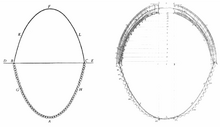Graphic statics
In a broad sense, the term graphic statics is used to describe the technique of solving particular practical problems of statics using graphical means.[1] Actively used in the architecture of the 19th century, the methods of graphic statics were largely abandoned in the second half of the 20th century, primarily due to widespread use of frame structures of steel and reinforced concrete that facilitated analysis based on linear algebra. The beginning of the 21st century was marked by a "renaissance" of the technique driven by its addition to the computer-aided design tools thus enabling the architects to instantly visualize form and forces.[2]
History[edit]

Markou and Ruan[3] trace the origins of the graphic statics to da Vinci and Galileo who used the graphical means to calculate the sum of forces, Simon Stevin's parallelogram of forces and the 1725 introduction of the force polygon and funicular polygon by Pierre Varignon. Giovanni Poleni used the graphical calculations (and Robert Hooke's analogy between the hanging chain and standing structure) while studying the dome of the Saint Peter's Basilica in Rome (1748). Gabriel Lamé and Émile Clapeyron studied of the dome of the Saint Isaac's Cathedral with the help of the force and funicular polygons (1823).[4]
Finally, Carl Culmann had established the new discipline (and gave it a name) in his 1864 work Die Graphische Statik. Culmann was inspired by preceding work by Jean-Victor Poncelet on earth pressure and Lehrbuch der Statik by August Möbius. The next twenty years saw rapid development of methods that involved, among others, major physicists like James Clerk Maxwell and William Rankine. In 1872 Luigi Cremona introduced the Cremona diagram to calculate trusses,[4] in 1873 Robert H. Bow established the "Bow's notation"[5] that is still in use.[4]
Concepts[edit]
Polygon of forces[edit]

To graphically determine the resultant force of multiple forces, the acting forces can be arranged as edges of a polygon by attaching the beginning of one force vector to the end of another in an arbitrary order. Then the vector value of the resultant force would be determined by the missing edge of the polygon.[6] In the diagram, the forces P1 to P6 are applied to the point O. The polygon is constructed starting with P1 and P2 using the parallelogram of forces (vertex a). The process is repeated (adding P3 yields the vertex b, etc.). The remaining edge of the polygon O-e represents the resultant force R.
In the case of two applied forces, their sum (resultant force) can be found graphically using a parallelogram of forces.
References[edit]
- ^ Pullen 1896, p. 1.
- ^ Markou & Ruan 2022, pp. 1390–1391.
- ^ Markou & Ruan 2022.
- ^ a b c Markou & Ruan 2022, p. 1390.
- ^ Hardy 1904, pp. 49–51.
- ^ Rennie & Law 2019, polygon of forces.
Sources[edit]
- Hardy, E. (1904). The Elementary Principles of Graphic Statics. B.T. Batsford. Retrieved 2024-02-02.
- Markou, Athanasios A.; Ruan, Gengmu (2022). "Graphic statics: projective funicular polygon". Structures. 41: 1390–1396. doi:10.1016/j.istruc.2022.05.049.
- Pullen, W.W.F. (1896). "Graphic Statics". The Application of Graphic Methods to the Design of Structures. Technical Publishing Company. Retrieved 2024-02-02.
- Rennie, Richard; Law, Jonathan, eds. (2019). "polygon of forces". A Dictionary of Physics (8th ed.). Oxford University Press. ISBN 9780198821472.
